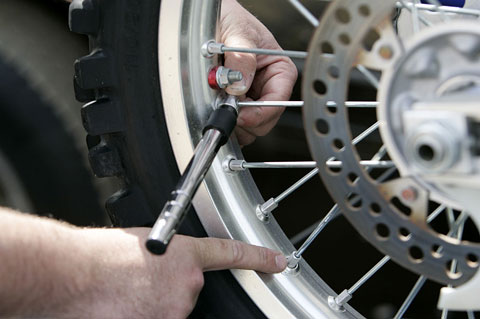

"I always start with a reference point. I like to start at the spoke next to the rim lock, tightening every fourth one. For example, you'd start at one, skip two and three, and tighten four. Then you'd skip five and six, and hit
 |
|---|
| Cole shows off his starting point, and the next spoke to tighten. Keep repeating that pattern around the wheel for three complete revolutions, until all your spokes are snug |
 |
| Cole's suitably proud of the Faastco spoke torque wrench. He says, "You cannot beat our quality. You're getting an American-made torque wrench that's the same specs as a Snap-On wrench. A big thing is how the wrench fit the nipple. On our wrenches, the heads are 10mm wide, and have real tight tolerances, so you don't round them off. That's important for bikes with aluminum nipples. It also has a lifetime guarantee, and is used by 99 percent of the factory mechanics out there." |
seven… on around the wheel. However you want to count it, you're hitting every fourth spoke. Doing it like this alternates sides, and helps spread the load evenly across the whole wheel. (See the first photo for a reference.)
On a 36-spoke wheel, you're going to end up where you started. Then you move to the second spoke after the rim lock, and go around again. On a 32-spoke, like a Honda rear wheel, you'll end on the one after, and you just keep going around three full revolutions. It takes three times around the wheel to hit all the spokes.
Of course, Cole's fond of torque, since Fasstco created the spoke torque wrench market back in '98, but whether you're using one of his wrenches or not, "It's real critical to sneak up on any torque. So you'll do quarter to half-turn at the most…even a half-turn's pretty liberal. It takes more time to go the quarter-turn route, but it's definitely worth it, because you're going to have even pull over the whole wheel, and it's going to be much stronger.
"Starting with a new wheel like on a new bike, and using a spoke torque wrench, you're probably going to get three to five the times the life out of your wheel. When you're doing it, especially right off the showroom floor, it's going to take a while to get those up to torque. The manufacturers don't put a lot of torque on them to start. That's why with a brand new bike, you go do one moto and your wheels will be really loose. If you torque them before you start, you're going to have a lot better chance of having a wheel that stays strong and true for the long-term.
"Our wrench is set at 48 inch-pounds, which is a good because it's not abusive to the components, and it's not going to loosen up on you. The only people who really run more than 48 inch-pounds are like Team Honda, or Mike Gosselaar on Carmichael's bike. They run 60 inch-pounds. But that puts a lot more stress on all the components. If you're not pounding Supercross whoops or going that speed, you'd be doing yourself a disservice running that much torque. Also, 99 percent of the people aren't going to notice the difference."
Reprinted with permission of ![]()